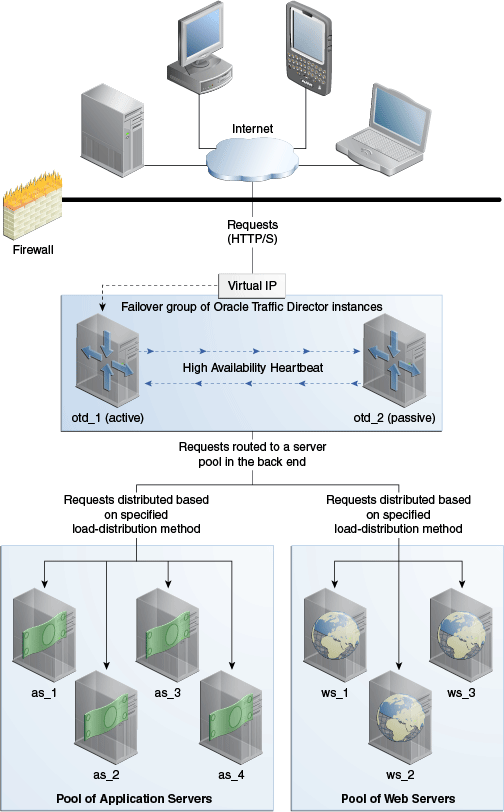1.3 Typical Network Topology
The network topology that you create for Oracle Traffic Director varies depending on your business requirements such as the number of back-end applications for which you want to use Oracle Traffic Director to balance requests, IT requirements such as security, and the features of Oracle Traffic Director that you want to use.
In the simplest implementation, you can have a single Oracle Traffic Director instance running on a dedicated compute node distributing client requests to a pool of servers in the back end.
To ensure that the node on which an Oracle Traffic Director instance runs does not become the single point of failure in the topology, you can have two homogenous Oracle Traffic Director instances running on different nodes forming an active-passive failover pair.
Figure 1-1 shows a typical Oracle Traffic Director network topology for a high-availability use case in an active-passive mode.
Figure 1-1 Oracle Traffic Director Network Topology: Active-Passive Failover Mode

Description of ''Figure 1-1 Oracle Traffic Director Network Topology: Active-Passive Failover Mode''
The topology shown in Figure 1-1 consists of two Oracle Traffic Director instances—otd_1 and otd_2—forming an active-passive failover group and providing a single virtual IP address for client requests. When the active instance (otd_1 in this example) receives a request, it determines the server pool to which the request should be sent and forwards the request to one of the servers in the pool based on the load distribution method defined for that pool.
Note that Figure 1-1 shows only two server pools in the back end, but you can configure Oracle Traffic Director to route requests to servers in multiple pools.
In the active-passive setup described here, one node in the failover group is redundant at any point in time. To improve resource utilization, you can configure the two Oracle Traffic Director instances in active-active mode with two virtual IP addresses. Each instance caters to requests received on one virtual IP address and backs up the other instance.
For more information about configuring Oracle Traffic Director instances in failover groups, see Section 14.2, "Creating and Managing Failover Groups."